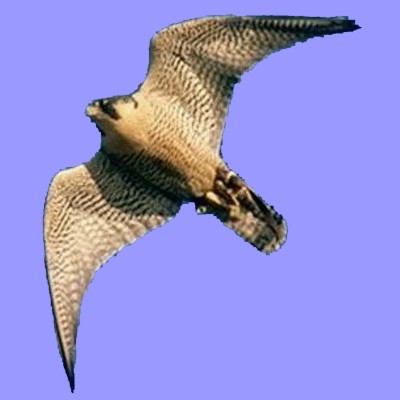Peregrine Falcon, Falco peregrinus
The Peregrine Falcon (Falco peregrinus), also known simply as the Peregrine, and historically as the “Duck Hawk” in North America, is a cosmopolitan bird of prey in the family Falconidae. The Peregrine Falcon has a body length of 38–50cm. As with other bird-eating raptors, the female is bigger than the male. The back and long, pointed wings of the adult are usually bluish black to slate grey with indistinct darker barring; the wingtips are black. The underparts are white to rusty and barred with thin clean bands of dark brown or black. The top of the head and a “moustache” along the cheeks are black, contrasting sharply with the pale sides of the neck and white trota.
 Main characteristics
Main characteristics
The immature bird is brown with streaked, rather than barred, underparts, and has a pale bluish cere. When hunting on its prey, for example doves or grouses, the Peregrine Falcon dives steeply at high speeds and hitting one wing of its prey so as not to harm itself on impact. Prey is struck and captured in mid-air; the Peregrine Falcon strikes its prey with a clenched foot, stunning or killing it, then turns to catch it in mid-air.
The Peregrine Falcon became a worldwide endangered species because of the use of pesticides, during the decade of the 60s. Pesticide interfered with reproduction, thinning eggshells and reducing the number of eggs that survived to hatching. In consequence, the Peregrine Falcon became extinct in many parts, such as the east of the United States.
On the Iberian Peninsula, the species is present throughout the year. However, its populations are small, for which it is considered a rare species.
Scientific classification: the Peregrine Falcon belongs to the Falconidae family, order Falconiformes. It’s scientific name is Falco peregrinus.
Peregrine Falcon, Falco peregrinus
Facts:
How are they? The Peregrine Falcon is the most common of all falcons. It has a body length of approximately 50cm and a wingspan of around 83–113cm, with the female measuring larger than the male. The Peregrine Falcon has long, pointed wings and a compact, aerodynamic body. The back is usually bluish black to slate grey with indistinct darker barring; the wingtips are black. The underparts are white to rusty and barred with thin clean bands of dark brown or black. It has a black “moustache” along the cheeks.
Where do they live? The Peregrine Falcon lives mostly along mountain ranges and woodlands.
How is the species geographically distributed? The Peregrine Falcon is the world’s most widespread bird of prey. It can be found nearly everywhere on Earth, excepting the Antarctic.
What do they feed on? Its diet consists almost exclusively of medium-sized birds in flight.


